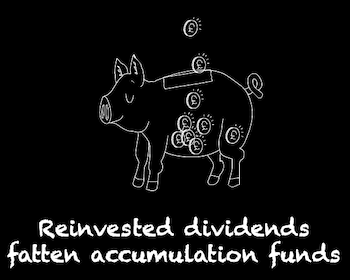An accumulation fund has a very simple job and that is to automatically reinvest dividends for you.
Instead of paying out your dividends (or interest) as cash, your income is put to work buying more of the fund’s underlying assets.
The counterpart to an accumulation fund is an income fund. An income fund sends dividends to your broker account for you to spend, save, or reinvest as you wish.
Income funds give you freedom to choose how to use your dividends. In contrast accumulation funds directly harness the power of compound interest to build your wealth.
Because they do that automatically, they make life simpler when growth is your priority.
What is an accumulation fund?
An accumulation fund is a variant of an open-ended investment fund. Standard open-ended investment fund types include Open-Ended Investment Companies (OEICs), Unit Trusts, and Exchange-Traded Funds (ETFs).
An open-ended fund such as a global index tracker may be made available in different versions that are known as share classes.
A single fund may come as an accumulation share class or as an income share class. Think of them as two flavours of the same thing – or perhaps the accumulation class as like the convertible version of your favourite car.
Both share classes represent your ownership of the same portfolio of underlying assets. But the classes confer different rights upon you.
In the case of the accumulation class of a fund, your dividends will be retained and reinvested for you in that fund.
An accumulating fund (or ETF) is just another name for an accumulation fund. The same goes for the terms acc fund or capitalising ETF.
They all do exactly the same job. That is to reinvest your dividends back into the fund.
How do accumulation funds work?
Accumulation funds work by purchasing more shares in the companies they hold with the dividends earned from the underlying investment portfolio.
This grows the value of your fund’s acc units (or shares), like a stalagmite reaching for the ceiling of a cave.
Bond accumulation funds work the same way. As your interest payments roll in they buy more of the fund’s underlying portfolio of bonds.
Your dividends do not buy you more units1 in an accumulation fund. That’s different to what you’d expect if you manually reinvested your income.
Instead, the reinvested dividends increase the worth of the underlying portfolio. This pumps up the price of every accumulation unit you own.
The effect on the value of your holdings is exactly the same as if you bought more shares with your dividends, however.
Our piece on income vs accumulation funds includes a chart that proves the point. The compounding happens — but in the price of the unit.
The upshot is that you’ll pay more for each unit of an accumulating fund than for one of its income fund counterpart.
But that doesn’t make the inc fund a more attractive bargain than the acc version.
Unit economics
Imagine the Monevator FTSE Human Folly Index Acc fund where:
- The accumulation units are priced at £2
- The income units are priced at £1
For every £2 that you have to invest, you can spend £2 to bag two £1 income units, or alternatively your £2 could buy you one accumulation unit.
Let’s now suppose the fund goes up 10%.
- The accumulation units are now worth £2.20
- The income units are now worth £1.10
Your cash return would be identical at 20p, whether you’d bought two income units or just one accumulation unit.
The only performance difference is that accumulation units will without doubt be compounding your dividends.
In the long-term, the value of a compounding accumulation fund will leave its non-compounding income twin in the dust.
But remember, the income unit owners are getting all those dividends to spend straightaway when they’re paid out. There’s no free lunch for anybody here!
When do accumulation funds reinvest dividends?
Accruing dividends are reflected in the price of an accumulation fund as they trickle in from the underlying investments.
Fund managers will reinvest at the most opportune moment while balancing investor cash inflows, outflows, and transaction costs.
However, accumulation funds still have an ex-dividend date. This determines whether you’re entitled to receive the dividends collected up to that point.
The day before the ex-dividend date:
- Fund units bought on this day are eligible for the declared dividend.
- Units sold on this date are not eligible.
The ex-dividend date:
- Previously held fund units sold on this day are still entitled to the declared dividend.
- Units bought on this day are not.
This all matters if you hold accumulation funds outside of your ISA or SIPP. That’s because tax is due on dividends, interest, and capital gains earned from acc funds, just as it is on income funds.
But calculating the tax you owe differs slightly as you must subtract your dividends from an accumulation fund’s capital gain. That way you’ll avoid being taxed twice on the same amount.
Our post on UK tax on reinvested dividends walks you through the calculation.
Thankfully you should receive a tax voucher from your broker detailing dividends earned on each of your accumulation funds, if you own them in taxable accounts.
Keep that paperwork safe. It’s paracetamol for self-assessment pain. And complain if you’re not receiving the voucher.
(Your first one may only arrive after the end of the first tax year that you’ve owned your accumulating fund.)
Dividend details
Your dividend entitlement doesn’t make any difference to the amount you buy or sell an accumulation fund for.
Accrued dividends are always baked into the price.
If you’re ineligible for the dividend when you bought – that’s okay. You haven’t inadvertently gamed the system. Your dodgy dividends are cancelled out because you effectively paid for them in the higher buy price.
And you don’t lose out on dividends rightfully earned when you sell. That’s because they’ve already swollen the sale price you receive.
Rest assured the system smooths out the complications, even though it’s not exactly intuitive.
Do accumulation funds pay dividends?
Yes, accumulation funds pay dividends. But they reinvest them straight back into your investment to boost its performance.
The dividends aren’t deposited into your broker account as cash as they are with income funds. (The way to realise acc fund dividends would be to sell units of your fund up to the value of the dividend.)
But how can you enjoy the thrill of watching your dividends payout like a fruit machine win when you can’t see them rack up in your account?
Well, you can track how much tax-sheltered accumulation funds have been fattened by dividends using the technique below…
How to find dividend distributions for accumulating funds
To find the dividend distributions of your accumulation fund:
- Go to Trustnet and search for your fund using the drop down menus on the home page.
- Most index funds will be in the Unit Trusts & OEICs section of the Fund Universe menu.
- There’s an ETF section in the same menu.
- Obscure foreign-domiciled funds and pension funds can be found in the Offshore Funds and Pension Funds drop-downs respectively.
- Click on the dividend tab from the fund overview.
- Make sure you click on the right fund. Trustnet tends to bundle lots of similarly named fund variants in the same place. This piece on comparing funds explains how to distinguish them.
- Multiply the dividend amount by the number of units you held the day before the ex-dividend date. That tells you how much you’ve earned in pounds and pence.
- Enjoy closet kicks from seeing the money flowing from Global Capitalism plc to You plc.
- Possibly plot the gains on some kind of spreadsheet. (How much do you want to stretch out the joy?)
Trustnet doesn’t always come up trumps. Here’s an alternative method:
- Go to Investegate’s advanced search page.
- Put your fund manager’s name (e.g. iShares) in the Company Name field.
- Set the All Categories field to Dividends.
- Change the Time Span field to something more generous like six months.
- Click the Search box if nothing happens automatically.
- A list of dividend payment announcements should come up.
- Click on the Dividend Payments link in the right-hand column.
- The dividend announcement should pop up. Read it and you’ll hopefully find your fund and its dividend result somewhere within.
Alternatively you can check your fund’s annual report, or email the fund provider.
Happy hunting!
Take it steady,
The Accumulator
- The same rules apply if your fund holdings are described as ‘shares’ not units. I’ll just use the term unit from now on to save time. [↩]







